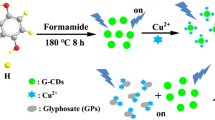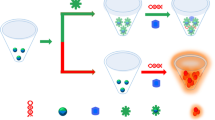Abstract
The widespread and extensive use of glyphosate in agriculture has raised concerns about its potential impact on the quality and safety of agricultural products. Conventional detection methods require long analysis times, making them impractical for the rapid detection of large quantities of samples. Therefore, developing a fast and simple detection system for glyphosate pesticide residues is urgent. In this study, the development of a facile fluorescence probe synthesized using a simple one-pot hydrothermal method for the determination of glyphosate is an important step toward addressing the need for a fast and simple detection system. The present sensor was created using bovine serum albumin (BSA) as a precursor, and the sensor operates by producing an “off–on” fluorescent signal. The bovine albumin-derived BSA-CDs emitted light yellow fluorescence, but this fluorescence was quenched (or suppressed) by the presence of Cu2+ ions. However, the fluorescence can be restored by the presence of glyphosate, which interacts with the Cu2+ ions to form a complex and release the BSA-CDs from suppression. The functional groups in glyphosate can capture Cu2+ and break the BSA-CDs/Cu2+ combinatorial system. The BSA-CDs/Cu2+ fluorescence quenching system had good selectivity for glyphosate. The detection limit of the BSA-CD/Cu2+ fluorescence sensor was 0.05 µg/mL. This developed method was utilized to successfully detect glyphosate in Chinese wheat. The average recoveries ranged from 98.9 to 100.7%, with a relative standard deviation < 3.0%, showing good prospects for practical applicability.







Similar content being viewed by others
Data availability
The authors declare that the data supporting the findings of this study are available within the paper. Should any raw data files be needed in another format they are available from the corresponding author upon reasonable request.
References
Thanomsit C, Saowakoon S, Wattanakornsiri A, Nanuam J, Prasatkaew W, Nanthanawat P, Mongkolvai P, Chalorcharoenying W (2020) The glyphosate (Roundup): fate in aquatic environment, adverse effect and toxicity assessment in aquatic organisms. Naresuan Univ J Sci Technol (NUJST) 28(1):65–81
Xu J, Smith S, Smith G, Wang W, Li Y (2019) Glyphosate contamination in grains and foods: an overview. Food Control 106:106710
Peillex C, Pelletier M (2020) The impact and toxicity of glyphosate and glyphosate-based herbicides on health and immunity. J Immunotoxicol 17(1):163–174
Clapp J (2021) Explaining growing glyphosate use: the political economy of herbicide-dependent agriculture. Glob Environ Chang 67:102239
Meftaul IM, Venkateswarlu K, Dharmarajan R, Annamalai P, Asaduzzaman M, Parven A, Megharaj M (2020) Controversies over human health and ecological impacts of glyphosate: Is it to be banned in modern agriculture? Environ Pollut 263:114372
Connolly A, Koslitz S, Bury D, Brüning T, Conrad A, Kolossa-Gehring M, Coggins MA, Koch HM (2020) Sensitive and selective quantification of glyphosate and aminomethylphosphonic acid (AMPA) in urine of the general population by gas chromatography-tandem mass spectrometry. J Chromatogr B 1158:122348
Zhang W, Feng Y, Ma L, An J, Zhang H, Cao M, Zhu H, Kang W, Lian K (2019) A method for determining glyphosate and its metabolite aminomethyl phosphonic acid by gas chromatography-flame photometric detection. J Chromatogr A 1589:116–121
Ye M, Lu X, Liu X, Zhang H, Du Y, Pan S (2018) Determination of glyphosate, glufosinate, and main metabolite aminomethylphosphonic acid residues in dry tea using ultra-high performance liquid chromatography-tandem mass spectrometry. Chin J Chromatogr 36(9):873–879
Pérez-Mayán L, Castro G, Ramil M, Cela R, Rodríguez I (2022) Approaches to liquid chromatography tandem mass spectrometry assessment of glyphosate residues in wine. Anal Bioanal Chem 414(3):1445–1455
Zhang H, Liu X, Huo Z, Sun H, Zhang F, Zhu B (2021) An ion chromatography tandem mass spectrometry (IC-MS/MS) method for glyphosate and amino methyl phosphoric acid in serum of occupational workers. Microchem J 170:106614
Shumilina E, Andreasen C, Bitarafan Z, Dikiy A (2020) Determination of glyphosate in dried wheat by 1H-NMR Spectroscopy. Molecules 25(7):1546
Sharma DK, Kumar N, Chaudhary A, Raj P (2020) Differential pulse polarographic investigations on glyphosate and glufosinate herbicides in relation to their environmental analysis. Bull Environ Contam Toxicol 105(1):95–102
Liu J, Feng W, Tian M, Hu L, Qu Q, Yang L (2021) Titanium dioxide-coated core-shell silica microspheres-based solid-phase extraction combined with sheathless capillary electrophoresis-mass spectrometry for analysis of glyphosate, glufosinate and their metabolites in baby foods. J Chromatogr A 1659:462519
Bafei EPM, Metowogo K, Eklu-Gadegbeku K (2021) Study of the health impact of glyphosate misuse in two prefectures in Togo and evaluation of its bioaccumulation in yam. Occup Dis Environ Med 9(4):199–213
Grau D, Grau N, Gascuel Q, Paroissin C, Stratonovitch C, Lairon D, Devault DA, Di Cristofaro J (2022) Quantifiable urine glyphosate levels detected in 99% of the French population, with higher values in men, in younger people, and in farmers. Environ Sci Pollut Res 29(22):32882–32893
Dovidauskas S, Okada IA, Dos Santos FR (2020) Validation of a simple ion chromatography method for simultaneous determination of glyphosate, aminomethylphosphonic acid and ions of public health concern in water intended for human consumption. J Chromatogr A 1632:461603
Chiesa LM, Nobile M, Panseri S, Arioli F (2019) Detection of glyphosate and its metabolites in food of animal origin based on ion-chromatography-high resolution mass spectrometry (IC-HRMS). Food Addit Contam Part A 36(4):592–600
Bettazzi F, Romero Natale A, Torres E, Palchetti I (2018) Glyphosate determination by coupling an immuno-magnetic assay with electrochemical sensors. Sensors 18(9):2965
Hu Y, Lin L, Li J, Ye J (2019) P, N Codoped carbon dots as an efficient “off-on” fluorescent probe for lipoic acid detection and its cellular dual-color imaging. Anal Bioanal Chem 411(16):3603–3612
Liu L, Qian M, Sun H, Yang Z-Q, Xiao L, Gong X, Hu Q (2022) A highly sensitive fluorescence probe for methyl parathion detection in vegetable and fruit samples based on N and S co-doped carbon dots. J Food Compos Anal 107:104374
Zhang X, Liao X, Hou Y, Jia B, Fu L, Jia M, Zhou L, Lu J, Kong W (2022) Recent advances in synthesis and modification of carbon dots for optical sensing of pesticides. J Hazard Mater 422:126881
John BK, Abraham T, Mathew B (2022) A review on characterization techniques for carbon quantum dots and their applications in agrochemical residue detection. J Fluoresc 32:1–23
Wareing TC, Gentile P, Phan AN (2021) Biomass-based carbon dots: current development and future perspectives. ACS Nano 15(10):15471–15501
Kang C, Huang Y, Yang H, Yan XF, Chen ZP (2020) A review of carbon dots produced from biomass wastes. Nanomaterials 10(11):2316
Hu Y, Li J, Li X (2019) Leek-derived codoped carbon dots as efficient fluorescent probes for dichlorvos sensitive detection and cell multicolor imaging. Anal Bioanal Chem 411(29):7879–7887
Dash SR, Bag SS, Golder AK (2022) Carbon dots derived from waste Psidium guajava leaves for electrocatalytic sensing of chlorpyrifos. Electroanalysis 34:1141–1149
Korah BK, Chacko AR, Mathew S, John BK, Abraham T, Mathew B (2022) Biomass-derived carbon dots as a sensitive and selective dual detection platform for fluoroquinolones and tetracyclines. Anal Bioanal Chem 414:1–17
Zhao Y, Jing S, Peng X, Chen Z, Hu Y, Zhuo H, Sun R, Zhong L (2020) Synthesizing green carbon dots with exceptionally high yield from biomass hydrothermal carbon. Cellulose 27(1):415–428
Kurian M, Paul A (2021) Recent trends in the use of green sources for carbon dot synthesis—a short review. Carbon Trends 3:100032
Lin B, Yan Y, Guo M, Cao Y, Yu Y, Zhang T, Huang Y, Wu D (2018) Modification-free carbon dots as turn-on fluorescence probe for detection of organophosphorus pesticides. Food Chem 245:1176–1182
Wu J, Chen X, Zhang Z, Zhang J (2022) “Off-on” fluorescence probe based on green emissive carbon dots for the determination of Cu2+ ions and glyphosate and development of a smart sensing film for vegetable packaging. Microchim Acta 189(3):1–9
Hou J, Wang X, Lan S, Zhang C, Hou C, He Q, Huo D (2020) A turn-on fluorescent sensor based on carbon dots from Sophora japonica leaves for the detection of glyphosate. Anal Methods 12(33):4130–4138
Yan X, Song Y, Zhu C, Li H, Du D, Su X, Lin Y (2018) MnO2 nanosheet-carbon dots sensing platform for sensitive detection of organophosphorus pesticides. Anal Chem 90(4):2618–2624
Zhang Z, Ma X, Jia M, Li B, Rong J, Yang X (2019) Deposition of CdTe quantum dots on microfluidic paper chips for rapid fluorescence detection of pesticide 2, 4-D. Analyst 144(4):1282–1291
Acknowledgements
The authors would like to thank the Agricultural Science and Technology Innovation Program of CAAS (CAAS-ZDRW202011), the National Natural Science Foundation of China (No. 32072313; 31772071), and the National Special Project for Quality and Safety Risk Assessment of Agricultural Products (GJFP20210105).
Author information
Authors and Affiliations
Corresponding authors
Ethics declarations
Conflict of interest
The authors declare that they have no known competing financial interests or personal relationships that could have appeared to influence the work reported in this paper.
Additional information
Publisher's Note
Springer Nature remains neutral with regard to jurisdictional claims in published maps and institutional affiliations.
Rights and permissions
Springer Nature or its licensor (e.g. a society or other partner) holds exclusive rights to this article under a publishing agreement with the author(s) or other rightsholder(s); author self-archiving of the accepted manuscript version of this article is solely governed by the terms of such publishing agreement and applicable law.
About this article
Cite this article
Wang, Q., Wang, M., Zheng, L. et al. BSA-carbon dots a promising “off–on” fluorescence probe for detecting glyphosate residues in agricultural products. Carbon Lett. 33, 1935–1945 (2023). https://doi.org/10.1007/s42823-023-00525-z
Received:
Revised:
Accepted:
Published:
Issue Date:
DOI: https://doi.org/10.1007/s42823-023-00525-z




